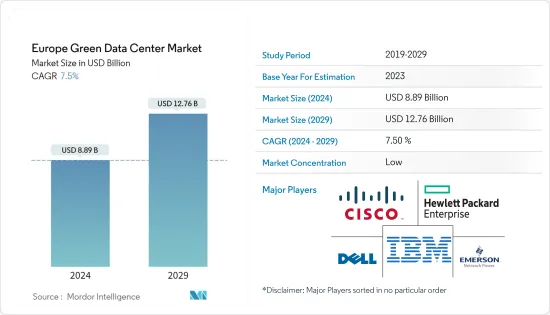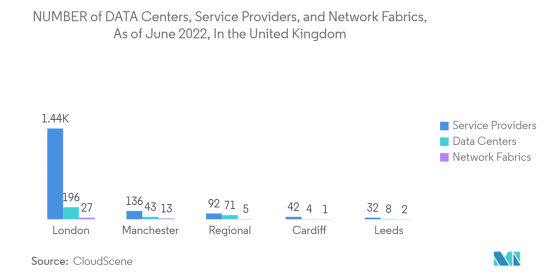PUBLISHER: Mordor Intelligence | PRODUCT CODE: 1403031

PUBLISHER: Mordor Intelligence | PRODUCT CODE: 1403031
Europe Green Data Center - Market Share Analysis, Industry Trends & Statistics, Growth Forecasts 2024 - 2029

The Europe Green Data Center Market size is estimated at USD 8.89 billion in 2024, and is expected to reach USD 12.76 billion by 2029, growing at a CAGR of 7.5% during the forecast period (2024-2029).
Key Highlights
- The technological innovations in data center technology, coupled with new developments in design, are enabling data centers to cut emissions and decrease power consumption by almost 80%. These are significant figures convincing European firms to invest in relatively expensive, greener technologies and infrastructure to reap considerably higher rewards in the future.
- The European green transition is largely made possible by data centers. In terms of progress toward decarbonizing its operations and making bold commitments to becoming climate-neutral, the data center sector is already among the most developed end-use sectors. At the same time, digital services are enabling businesses in all economic sectors to innovate, increase efficiency, create sustainable products and services, and achieve their ambitious climate targets in line with the objectives of the European Green Deal. The European Commission has created guidelines to assist data centers in becoming more energy-efficient, recovering waste energy, such as heat, and using more renewable energy sources, with the goal of becoming carbon-neutral by 2030.
- Western and Northern European countries are ahead of the rest of Europe regarding sustainability and sustainable energy management, particularly Russia and Eastern Europe, which have traditionally been slow adopters of sustainability and efficiency practices. Iceland is becoming a hot hub for data centers due to the 15-year visibility into energy pricing provided by the National Power Company. A geologically and physically secure location with natural outside cooling is one of the key factors in its effective energy management.
- The Product Environmental Footprint (PEF) pilot, led by the European Commission, is set to provide many tangible benefits of the Environmental Product Footprint for the data center industry today. Still, the majority of the potential will be realized in later years. This is set to drive companies to incorporate processes and procedures that minimize their environmental footprint while not compromising the importance of bringing products to the market that meet evolving technology trends.
- A number of projects got delayed as a result of the supply chain being hampered by the COVID-19 pandemic. Due to supply chain issues involving hardware components from significant IT manufacturers, the market expanded gradually during the pandemic. Additionally, statistics from the International Energy Agency (IEA) show that during the pandemic, the world's energy demand decreased by about 6% in 2020. As a result, along with the effects of policies aimed at achieving climate carbon-neutral goals, the significant decline in GDP and energy consumption contributed to the EU's achievement of its renewable energy target and its goal to increase energy efficiency by 2030.
Europe Green Data Center Market Trends
Energy efficient cooling systems will Drive the Market
- The increased number of data centers and higher density in data centers have created a demand for effective cooling. These system types are standard in institutions with limited infrastructure. Such factors are propelling the deployment of energy-efficient cooling systems and hence increasing the market demand.
- Data center equipment needs to be kept cool. The size, location, and data center design all influence the cooling method to be selected. In order to reduce energy consumption and the carbon footprint while optimizing PUE, WUE, and ERE, as well as the capacity of data center equipment, as well as downtime must be minimized.
- The lower the PUE, the greater the effectiveness, with 1.00 being the absolute highest level of effectiveness. A tested and validated data center called Boden Type Data Center (BTDC), the EU-funded BodenTypeDC project constructed. The BTDC One has achieved a PUE of less than 1.02. Data centers in the EU have an average PUE above 1.5. It operates on renewable energy and depends on free air and evaporative cooling technologies without the necessity for refrigerants.
- Server uptime is increased with the use of effective data center cooling technology. Any failure at the server level will have effects on businesses and users since overheating can be disastrous in a professional setting that demands more than 99.99% uptime.
- Whether the data center manager intends for a cold aisle setup or a hot aisle to be present, hot spots can emerge in data centers quickly, necessitating the need for fast and effective solutions. This demands utilizing air-cooling systems or liquid cooling technologies that allow for simple adaptation of the way cold air is utilized in the whole system. Overall, this enables a data center to scale up more efficiently.
- Compared to traditional air-cooled systems, liquid-based cooling methods can save up to 98% of the energy needed to cool servers. Datacenter liquid-based cooling systems use 60% less room than traditional air-cooled systems. Because liquid-based Cooling Systems servers are so reliable, they may be operated for far longer periods than traditional servers. A 200 kW edge data center with liquid-based cooling systems can cut its carbon emissions by 700,000 kg of CO2 by reducing the whole edge data center electricity usage by 40% or more.

Energy Efficiency and Carbon Neutrality will drive the adoption of Green Data Centers
- According to the International Energy Agency, data centers absorb 1% of all worldwide electricity, and by 2025, they will consume 1/5 of the world's power supply. Most energy consumption is for powering the servers, but they also generate heat and must be cooled. HVAC and cooling systems are required to cool the entire system, which necessitates the use of additional power. As a result, to reduce power usage and carbon footprint, energy-efficient systems and technology are necessary.
- Green Data Centers are in charge of making optimum use of computer resources while also being environmentally friendly. In data centers, low-power servers are more energy-efficient than traditional servers. They employ smartphone computing technology to strike a balance between performance and energy usage.
- The European Green Deal aspires to make Europe the first continent to achieve carbon neutrality. Green and digital transformation should be viewed as complementary. The European Commission's paper "Shaping Europe's Digital Future" states that data centers must be carbon-neutral by 2030.
- The European Union has made energy-efficient cloud computing a primary focus. To be carbon-neutral by 2030, data centers must become more energy-efficient, utilize waste energy such as heat, and employ more renewable energy sources.
- A group of Europe's major data center operators has formed and signed a green data center pact, pledging to self-regulate before European Union officials approve data center sustainability legislation. This uncomfortable possibility has hung over the bloc's industry for more than a year. The Climate Neutral Data Centre Pact, lays out efficiency and renewable energy goals for data centers and ambitious targets for achieving them. It creates a framework for measuring progress toward those objectives.
Europe Green Data Center Industry Overview
Europe green data center market is fragmented as vendors adopt inorganic growth strategies such as strategic partnerships and mergers and acquisitions to expand the market foothold. Key players are IBM, Cisco Systems, Inc., Dell Technologies Inc., etc.
In September 2022, A new data center of OVHcloud is being constructed in Limburg, Germany. The new building, which was first announced in April 2022, would have more than 6,000 square meters (64,580 sq ft) of floor space available for 40,000 servers, which OVH stated equates to a storage capacity of 100 exabytes. OVH highlighted the green qualities of the new facility. According to the company, the new data center will get 100 percent of its electricity from renewable sources. Also, OVHcloud will be using its patented water cooling technology, waste heat from the servers will be used for underfloor heating in the adjoining offices, and will have an ecological green roof with plants on the facades and trees on the site.
In July 2022, In Hanu, Germany, a sizable data center park is being planned by European logistics real estate company P3 Logistic Parks. At least eight data center modules will be developed on a building area of about 200,000 square meters (2.1 million square feet) over 10 years, with an electrical supply of 180 megawatts (MW) at the site. Construction will be done in phases. The on-spec campus, according to P3, would be developed and run sustainably, and it will be powered entirely by renewable energy.
Additional Benefits:
- The market estimate (ME) sheet in Excel format
- 3 months of analyst support
TABLE OF CONTENTS
1 INTRODUCTION
- 1.1 Study Assumptions and Market Definition
- 1.2 Scope of the Study
2 RESEARCH METHODOLOGY
3 EXECUTIVE SUMMARY
4 MARKET INSIGHTS
- 4.1 Market Overview
- 4.2 Industry Attractiveness - Porter's Five Forces Analysis
- 4.2.1 Bargaining Power of Suppliers
- 4.2.2 Bargaining Power of Consumers
- 4.2.3 Threat of New Entrants
- 4.2.4 Intensity of Competitive Rivalry
- 4.2.5 Threat of Substitute Products
- 4.3 Industry Value Chain Analysis
- 4.4 Impact of COVID-19 on the Market
- 4.5 Industry Regulation and Policies
5 MARKET DYNAMICS
- 5.1 Market Drivers
- 5.1.1 Increasing Demand for Data Storage
- 5.1.2 Focus on Energy Efficiency
- 5.2 Market Restraints
- 5.2.1 Higher Initial Investments
6 MARKET SEGMENTATION
- 6.1 Service
- 6.1.1 System Integration
- 6.1.2 Monitoring Services
- 6.1.3 Professional Services
- 6.1.4 Other Services
- 6.2 Solution
- 6.2.1 Power
- 6.2.2 Servers
- 6.2.3 Management Software
- 6.2.4 Networking Technologies
- 6.2.5 Cooling
- 6.2.6 Other Solutions
- 6.3 User
- 6.3.1 Colocation Providers
- 6.3.2 Cloud Service Providers
- 6.3.3 Enterprises
- 6.4 Industry Vertical
- 6.4.1 Healthcare
- 6.4.2 Financial Services
- 6.4.3 Government
- 6.4.4 Telecom and IT
- 6.4.5 Other Industry Verticals
7 COMPETITIVE LANDSCAPE
- 7.1 Company Profiles
- 7.1.1 Fujitsu Ltd
- 7.1.2 Cisco Technology Inc.
- 7.1.3 HP Inc.
- 7.1.4 Dell EMC Inc.
- 7.1.5 Hitachi Ltd
- 7.1.6 Schneider Electric SE
- 7.1.7 IBM Corporation
- 7.1.8 Eaton Corporation
- 7.1.9 Emerson Network Powers
- 7.1.10 GoGrid LLC
8 INVESTMENT ANALYSIS
9 FUTURE OF THE MARKET




